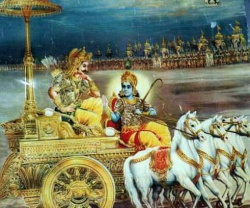Svarga
In Hinduism, Svarga (or Swarga) (Sanskrit: स्वर्ग) also known as Swarga Loka is a one of seven loka or planes in Hindu cosmology, which sequentially are Bhu loka (Prithvi Loka, Earth), Bhuvar loka, Swarga loka, Mahar loka, Jana loka, Tapa loka, and the highest Satyaloka (Brahmaloka).
It set of heavenly worlds located on and above Mt. Meru. It is a heaven where the righteous live in a paradise before their next reincarnation. During each pralaya or the great dissolution, the first three realms are destroyed that is Bhu loka (Earth), Bhuvar loka, Swarga loka. Below all these upper realms lie seven realms of Patala, the underworld and netherworld
Svarga is seen as a transitory place for righteous souls who have performed good deeds in their lives but are not yet ready to attain moksha, or elevation to Vaikunta, the abode of Lord Vishnu, considered to be the Supreme Abode (Rig Veda (1.22.20) states, Oṃ tad viṣṇoḥ paramam padam sadā paśyanti sūrayaḥ:
"All the suras (i.e., the devas) look towards the feet of Lord Vishnu as the Supreme Abode"). The capital of Svarga is Amaravati and its entrance is guarded by Airavata. Svarga is presided over by Indra, the chief deva.
This is a "Good and nice" kind of temporary heaven where the soul enjoys all its Punya karmam before attaining either moksha, or rebirth according to its Karma.
